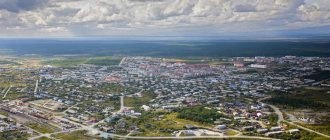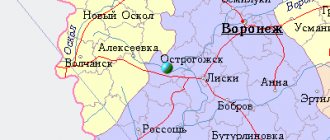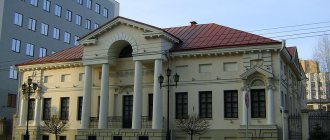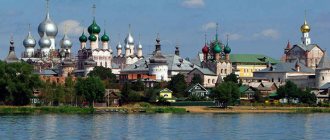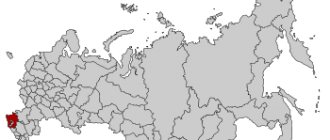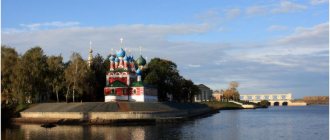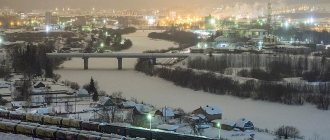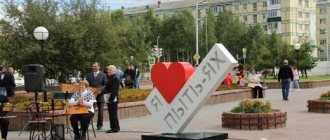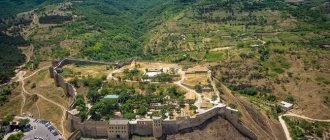Immediately at the entrance to the city of Kologriv there is a beautiful two-story red brick building that houses a local history museum. If you ask local residents what was in this house before, you will hear: “Some timber merchant built a railway station...”. However, don't bother and don't look for railroad tracks. They were never here. This is a legend. A large swampy plot of land, located on the outskirts of the historical part of the city, belonged to the wealthy merchant Gavriil Vladimirovich Makarov. In 1899, a two-story house was built here, the author of which, according to local historians, was the famous Moscow architect I.I. Rerberg.
In the early 1900s, when discussing the issue of the Northern Railway route, Makarov was one of the most ardent supporters of running it through Kologriv and promised in this case to give his house as a railway station. However, due to the machinations and intrigues of timber merchants, the railway was laid a hundred kilometers to the south - through Bui and Manturovo.
This story gave rise to a widespread legend that the building was built specifically for the station, which did not have a road. The house that Makarov built turned out to be large and empty until a museum was placed in it. In 1914, Gennady Aleksandrovich Ladyzhensky, an artist and academician, retired and returned to his hometown, founded a private museum in Kologriv. In 1918, after the establishment of Soviet Power in Kologriv, this private museum was reorganized into a state art and historical museum.
Its basis, as before, was made up of a private collection of paintings, antiques, a collection of weapons, fabrics, carpets, a collection of ethnographic objects, porcelain, bronze, rarities, a native of the city of Kologriv, teacher of the Odessa Real School, academician artist Gennady Aleksandrovich Ladyzhensky. On October 26, 1919, on the recommendation of Fyodor Stepanovich Chumbarov-Luchinsky, based on the collection of local historian V.P. Chistyakov, a second museum of local history was opened. It told about the life of a rural worker, about the connection between the city and the countryside. In 1925, both museums, local history and art history, were united and moved to the thoroughly renovated Makarov house.
In the 1930s, the museum's attention was directed to studying the history, economy and nature of its native land. During this period, there was an interest in the study of handicrafts and folk applied arts, and material was collected reflecting the life and history of the native land. During the Great Patriotic War, evacuees from the city of Leningrad did a lot of work in restoring the museum, disassembling exhibits, scientifically describing them, building the exhibition and distributing it among departments and halls. These are: Olga Filippovna Taube, a former researcher at the Russian State Museum and the Hermitage, and her daughter, Maryana Evgenievna Glinka, a guide at the Gatchina Museum. They worked at the Kologriv Museum from November 1, 1943 to September 1, 1944. Taube’s son-in-law, director of the Institute of Literature of the Academy of Sciences, Vladislav Mikhailovich Glinka, gave a lot of useful advice. According to his recommendations, galleries of Russian artists and foreign paintings were developed and built.
In the post-war years, the role of collecting material for the museum belonged to the public. Materials were selected that reflected the state and development of agriculture, exhibits characterizing the growth of local industry, materials on public education, health care, portraits, photographs, letters from fellow countrymen who were awarded orders and medals.
Since January 1978, it has become a branch of the Ipatiev Monastery Museum-Reserve. In 2003, in response to a petition from the museum staff, the Kostroma Regional Duma decided to name the Kologriv Museum of Local Lore after the outstanding fellow countryman of the artist Gennady Aleksandrovich Ladyzhensky.” Since 2005, the museum has been a branch of the Kostroma State Historical, Architectural and Art Museum-Reserve.
Kologriv
encyclopedic Dictionary
Kologriv is a city (since 1778) in Russia, Kostroma region, pier on the river. Unzha, 8 km from the Manturovo railway station. 4.0 thousand inhabitants (1998). Butter and cheese plant; lespromkhoz. Museum of Local Lore.
* * *
KOLOGRIV - KOLOGRIV, city (since 1778) in the Russian Federation, Kostroma region, pier on the river. Unzha, 81 km from the Manturovo railway station. Population 3.9 thousand people (2002). Butter and cheese plant; lespromkhoz. Museum of Local Lore.
large encyclopedic dictionary
KOLOGRIV is a city (since 1778) in the Russian Federation, Kostroma region, pier on the river. Unzha, 81 km from the railway. Art. Manturovo. 4.2 thousand inhabitants (1992). Butter and cheese plant; lespromkhoz. Museum of Local Lore.
synonyms
noun, number of synonyms: 1
city (2765)
grammar dictionary
Description
Kologriv, Kostroma region. City website kologriv.com
Wiki: ru:Kologriv en:Kologriv de:Kologriw es:Kologriv
The city of Kologriv in the Kostroma region (Russia), description and map linked together. After all, We are places on the world map. Explore more, find more. Located 208.8 km north of Nizhny Novgorod. Find interesting places around, with photos and reviews. Check out our interactive map with places around you, get more detailed information, get to know the world better.
Interesting places: Museum of Local Lore named after. G. A. Ladyzhensky, Sudilovo, Todino, Memorial Park, Secondary School, Assumption Cathedral, Kuibyshe no. 44, Kindergarten Romashka, Fire Station No. 20, Kindergarten No. 3
Kologriv
The town of Kologriv, located in the northeast of the Kostroma region, is a typical Russian province, a classic wilderness and “bear corner”. The roads here are very bad, to put it mildly, a depressed economy and a neglected appearance of dying settlements. All this is true, but at the same time, there are many amazing things on the Kologriv land, for which you can come to this protected corner of the Russian land. I invite travel lovers to visit the Kologrivsky district - a protected region of Russia! Reason 1. Station without a railway The city of Kologriv is a place where there is a railway station without a railway. Now the local history museum named after G.A. Ladyzhensky is located here - the pride of Kologriv residents and one of the best regional museums in Russia. The museum was founded by academician of painting, “king of watercolors” Gennady Ladyzhensky. The spacious halls of the old merchant mansion display exhibitions on the history and nature of the local region. In the excellent art department you can see paintings by Russian artists: Kramskoy, Shishkin, Bryullov, Fedotov, Shevchenko, Borovikovsky and others, as well as Western European painting from the 18th to 19th centuries. Much attention is paid to the work of two famous Kologriv artists - G.A. Ladyzhensky and E.V. Chestnyakova. Reason 2. The Goose Kingdom The city of Kologriv is the only place in Russia where every spring thousands of wild geese live almost within the city limits. The Kologrivskaya Poima ornithological reserve, where geese and other birds live from April to mid-May, has been declared a specially protected natural area. In honor of migratory birds, an interesting holiday, Goose Day, is held in early May, and the city itself rightfully bears the title of “Goose Capital of Russia.” Reason 3. Relict taiga In the vicinity of Kologriv, the only area of primeval taiga in Europe has been preserved, which has never known deforestation and forest fires. A hybrid species of Kologriv spruce grows here (Siberian spruce and Norway spruce “are found” in Kologriv), reaching enormous sizes. Now this site is under state protection on the territory of the Kologrivsky Forest named after M.G. Sinitsyn reserve. The staff of the institution conduct excursions in the reserve. Reason 4. Fabulous artist Chestnyakov Kologriv land is the birthplace of the unique peasant artist, poet, thinker and righteous man Efim Chestnyakov, whose work is actively studied and preserved in the region. In the house-museum of E.V. Chestnyakov in the village of Shablovo you can get acquainted with the life and work of this amazing person, see original things, paintings, drawings and sculptures of the artist. You can get acquainted with the amazing and interesting world of the old Russian village in the ethnographic hut, where museum staff conduct interactive programs and even treat you to a delicious peasant lunch from a Russian oven. Reason 5. The district town of Kologriv Kologriv is one of the smallest cities in Russia; it has retained to this day the unique appearance and charm of a small district merchant town. Here you will not see public transport, Khrushchev buildings, typical Soviet buildings, bustling crowds of people and industrial buildings, but you can admire dozens of monuments of provincial architecture. Walking around Kologriv, which has an integral architectural ensemble, you will certainly feel like a time traveler who, by the will of fate, found himself in the 19th century. Reason 6. Princely Hermitage To the north-east of Kologriv, among the endless taiga, on the top of a high mountain is the Princely Hermitage, a former monastery. There is amazingly beautiful nature here, a historical place covered in legends and traditions. For centuries, pilgrims from different parts of the Russian state have sought to come here. Under the Holy Mountain, to the left of the churches, there are holy springs, the water in which is considered healing and holy. Once upon a time, huge holy linden trees grew on the mountain, gnawed by the teeth of thousands of pilgrims - it was believed that the bark of these trees could relieve toothache. The descendants of the holy linden trees still grow near the temples. In recent years, a chapel has been built here, the holy springs have been improved, a bathhouse has been built, and a guest house for pilgrims has been built. Reason 7. Chizhovsky complex. One of the most interesting places in the Kologrivsky district is the village of Ekimtsevo, where since the end of the 19th century. the Agricultural School named after F.V. Chizhov was located - one of the best vocational educational institutions in pre-revolutionary Russia. The beauty and pride of the village is the main educational building, built in 1891-92 according to the design of the famous architect I.V. Shtrom. The impressive two-story building on semi-basements is richly decorated with exposed brickwork. Large lancet windows and other architectural details make it look like a Gothic medieval castle. Reason 8. Monster. The dense forests in the north of the Kologrivsky district near the Markhanga and Stepanovka rivers are a place where a mysterious three-meter creature covered with fur has been seen more than once. In different parts of the Earth this creature is called Yeti, Bigfoot, Sasquatch, Almasty, and the Kologriv Bigfoot was nicknamed “monster” by local residents. There is an excursion “In Search of the Beast” to the places where Bigfoot lives, and who knows, maybe you will be “lucky” to see the owner of the forest. The spectacle, however, is not for the faint of heart and remains in the memory for a lifetime. In honor of the local yeti cub Snezhka, Kologriv residents hold a fun holiday “Kologriv Snowball Day” at the beginning of January. Reason 9. Unzha River. The Unzha River, which flows through the entire region, is amazingly beautiful and picturesque. Unzha is an ideal place for water sports tourism. Along the entire length of the river there are many beautiful and convenient places for parking, as well as beautiful sandy beaches. There are many sights along the way: ancient villages with preserved temples, the village of Shablovo - the birthplace of E.V. Chestnyakov, the original Kologriv - a fortress on the border with the Kazan Khanate, the village of Ekimtsevo, where the beautiful educational park complex of the former Chizhov Agricultural School is located, the ancient cities of Kologriv and Makariev. In many places there are deposits of fossil rocks from the Jurassic period; you can easily find ammonites, which locals call “urash stones”, as well as belemnites – “devil’s fingers”. The main fish species in the river are chub, pike perch, asp, burbot (cod family), perch, dace, bream, ide, pike, and sorog. Reason 10. Kologriv nature. The nature of the Kologriv land is wonderful; it’s not for nothing that our region is called the “Reserved Land of Russia.” Beautiful white moss forests, picturesque forest rivers, an abundance of animals, berries and mushrooms invariably attract numerous nature lovers, outdoor enthusiasts, as well as fishermen and hunters to Kologriv. The area has interesting natural sites, for example, former lordly parks and alleys, cranberry bogs, a unique huge pine tree in the village of Urma, included in the register of old-growth trees in Russia, and many others.
The Kologriv region is an endless taiga, clean air, crystal water of forest rivers, holy places and unique natural sites, hunting and fishing, wonderful architectural monuments and much, much more. Be sure to come visit us and see for yourself! Welcome to Kologriv!
How to get to us Kologrivsky district is located in the northeast of the Kostroma region, 360 km from Kostroma, 640 km from Moscow, 90 km north of the city of Manturovo (Northern Railway station). You can get to Kologriv as follows. By train to Manturovo railway station. From there to Kologriv 2 times a week (Tuesday and Thursday, 8-00 and 12-00) there is a regular bus, or you need to take a taxi at the station (1200-1500 rubles). By road from Moscow you need to go along the Yaroslavskoe highway to Kostroma, then along the Kostroma - Verkhnespasskoye highway to the village of Elizarovo, Manturovo district. Behind the bridge over Unzha there will be a turn to Kologriv along the Elizarovo - Kologriv road (50 km). A regular bus runs daily from Kostroma to Kologriv.
For questions related to travel to the Kologrivsky district, accommodation, excursions to local attractions, please contact the department of culture, tourism, sports and youth of the Kologrivsky district administration. Contact person – Timganov Emil Kabirovich, phone (49443)4-15-43, 8-910-807-37-83 e-mail [email protected] More information about tourism in Kologriv can be read here: emiltim.livejournal.com
Chip flights
Find a hotel

